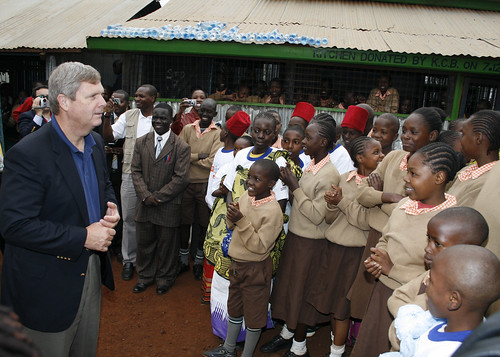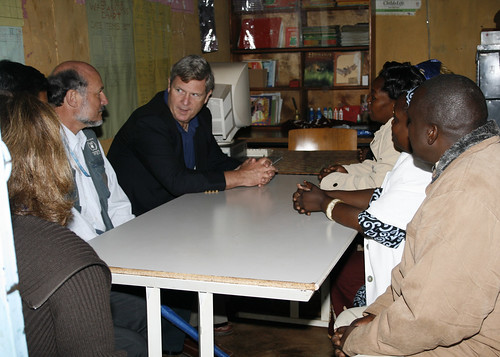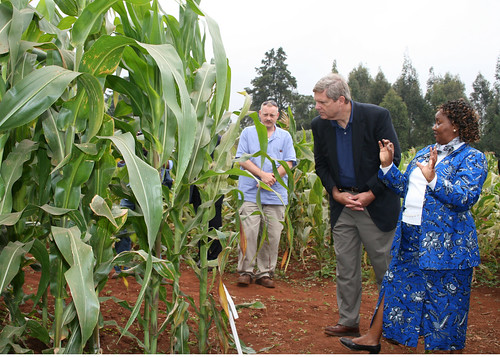
Chris Mather, USDA Director of Communications, traveled with Secretary Vilsack to Kenya for the AGOA (African Growth and Opportunity Act) Summit. Today she shares her thoughts on segments of the trip when they traveled beyond the city limits of Nairobi for educational events.
Last week, Secretary Vilsack traveled to Nairobi, Kenya, as a participant in the 2009 African Growth and Opportunity Act Summit. Amid bilateral talks and attending the opening meeting with Secretary of State Hillary Clinton and United States Trade Ambassador Ron Kirk, the Secretary had an opportunity to travel to the countryside to learn more about the agriculture industry in Kenya and see firsthand some of the efforts USDA has been supporting.
Tuesday morning, we were up early and out of Nairobi to visit an agrodealership in Muguga. The Secretary toured the small shop, which provides production supply, seed and equipment to farming operations throughout the region, and learned about the dealership’s role in providing local subsistence farmers with supplies at reasonable prices. He also met a business owner who sells water pumps to farmers to help them irrigate their land.
After the visit, we travelled to a one acre farm owned by Mary and James Karanja outside Nguriunditu village. Mary and James have two cows and two calves, 200 chickens, and along with their four children, they raise a variety of crops – corn, beans, potatoes, bananas, and vegetables. The family’s farm, which provides their only source of income and is typical for many Kenyan producers, gave us all remarkable insight into the everyday operations of family farms in the country.

We then travelled to KARI (Kenya Agricultural Research Institute) in Muguga – a premier research institution conducting studies on production agriculture, horticulture, resource management and socio-economics. We learned about KARI’s research centers; the institute maintains more than 20 throughout the country, allowing KARI to respond to regional needs and opportunities, and involve more Kenyan researchers. The Secretary was able to meet with researchers at the center, and we all learned about fellowships offered to assist in development of Kenyan research capacity.
He also was able to talk to the recipients of the AWARD (African Women in Agricultural Research and Development) fellowships -- awarded to a select number of highly-talented women who are bringing their unique scientific and development expertise to research new possibilities for African agriculture. The women come from 48 different research institutions in the region, and through AWARD will be able to further develop their research and leadership skills in a country where 80 percent of farmers are women, yet only 5 percent of agricultural extension services and 10 percent of rural credit reaches women.
At the end of a busy morning, the Secretary headed for Kibera, where he visited the STARA Rescue Center School Feeding Center which is supported by the World Food Programme. Before meeting with the Headmistress of WFP, a program to which the United States is the largest contributor, the Secretary entered the center to a really wonderful greeting by all of the children.
It was a touching place to be. The children get free primary education at the school, but money is often lacking for basic school supplies; the World Food Programme works to help the school put food on tables for the kids. Even so, everyone was in very high spirits for the visit, and the children were excited to show the Secretary and the rest of us the school grounds. The Secretary was able to spend some time on a tour of the school’s garden (led by the students themselves!) and serving food to the kids for lunch; later, he met with WFP’s country director and Ambassador Michael Ranneberger.
The meeting with the kids at Kibera marked the end of a whirlwind, informative day outside the capital. Next we’d be back to Nairobi, where Secretary Vilsack spent a day and a half participating in bilateral talks with leaders in Sub-Saharan Africa before returning to Washington.
Although we weren’t able to spend a long time traveling in the country, the visits the Secretary was able to make provided us all with a better understanding of the agricultural economy and everyday life in Kenya – an understanding that will be very helpful as the Secretary works to help countries throughout Africa strengthen their production capacity.

